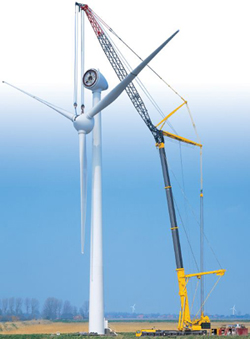Facing High Winds: Cranes & wind tower construction
 Choosing a wind energy site often includes a remote location. Sometimes this location is found on a vast, flat plain or high above on a mountaintop. Either way, plenty of wind is guaranteed if the site is deemed to be successful.
Choosing a wind energy site often includes a remote location. Sometimes this location is found on a vast, flat plain or high above on a mountaintop. Either way, plenty of wind is guaranteed if the site is deemed to be successful.
But when looking at a wind energy site, most people don’t consider the challenging, even ironic, nature of constructing towers. Challenging in terms of the terrain, which is often times rocky, uneven, and difficult to maneuver around. And, ironic in terms of the wind—the very reason the site was selected was because of this gusty feature and, yet, this feature makes for a difficult construction site where safety can be a risk. This is true especially when one considers the height of most towers.
The need for cranes on a windy, mountaintop certainly brings challenges to any wind energy construction site. Interestingly, when looking at a typical load chart for a crane, the one item listed which is an exception to the load limit indications: wind speed.
Crane considerations
When one considers a crane at work, one likely thinks of it in terms of lifting heavy objects into position and then setting those objects into their final resting place. When that final position is somewhere between 80 to 100 meters high (262 to 328 feet) atop a large wind tower, however, this requires a very long boom. And, this long boom requires a large stable base to lift those objects that high in the air without toppling over. Additionally, the weight of the objects lifted needs to be factored in—which, on large wind projects, can easily reach 70-plus tons (15,4000-plus pounds). To meet these demands, the size and capacity of a crane must be very large and sturdy.
The large cranes used for assembling wind towers must also be agile enough to travel the rugged terrain to the project site. They must have a small enough footprint to travel on small access roads, and still be big enough in capacity to perform their lift duties. Once a crane is placed into position for assembling the pieces that will become a wind tower, there’s still one major consideration, which is the wind.
Calculating the wind
Wind affects every component of the lift operation of a crane. Conditions must be near perfect before lifting, and are constantly monitored through use of wind gauges, weather stations, and extended forecasts. As it’s usually extremely windy on wind farm locations, special care in calculating the exact load force that’s being lifted is crucial. Wind speed influences the load capacity of the crane.
Moreover, since some of the items being lifted are designed to catch the wind, special calculations are needed to determine the actual wind speed allowed to make a lift. In most cases, the allowed speed is considerably less than the wind speed listed on the load charts.
Size and shape of items being lifted can multiply the affects of the wind already present, and these factors have their own set of equations to determine sail area. Without getting into specific formulas, consider a sail area in this way: you are standing upright with your arms at your side, and are facing a strong breeze. Notice the effort required to stand upright and stay completely still. Now, raise your arms, outstretched to your side, and feel how that same breeze changes the amount of effort needed to stand upright without getting blown backwards. When you raise your arms, you increase your sail area.
Wind direction can also have an effect on a load being lifted. Depending on direction, the load may be heavier or lighter than its static weight. To return to our example, face the same strong breeze as before and begin running. Notice the effort required to run and maintain speed. Now, turn around and begin running. Notice how much easier it is to run with the wind at your back. This same principle can affect the Load Moment Indicator (LMI) system in a crane, giving false load readings to the operator.
Wind gusts cause the greatest threat during the lifting operation. These gusts are unpredictable and can cause side loading by blowing a load perpendicular to the boom angle. Heavy lift booms are designed for vertical stresses, not for side load stresses. If a large gust comes when a heavy load with a large sail area is lifted high in the air, this can create a very dangerous situation. The boom can break or the crane can topple sideways, causing the heavy load, rigging, and broken parts to come crashing to the ground.
Wind speed at ground level is often quite different than at 80 to 100 meters in the air. Special attention to the wind speed indicator on the boom tip is essential for safe lifting operations. Even with all the special calculations and attention to weather and wind, accidents do happen. When considering a wind energy site, bear in mind the challenges of construction and the important—and difficult—role cranes play in building the final towers.
Alan Hemingway is the product manager for Liebherr Cranes, Inc.
Liebherr Cranes, Inc.
www.liebherr.com
Author: Alan Hemingway
Volume: May/June 2012








